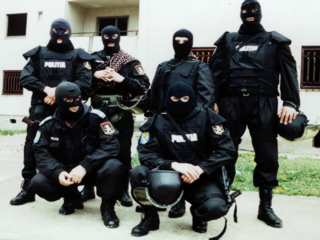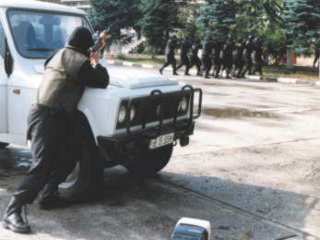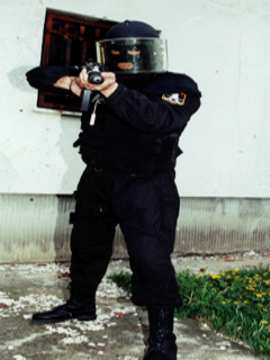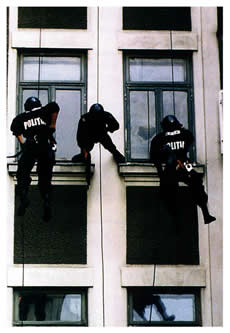Admission
DIAS fighters are usually chosen from young people. A previous carreer in martial arts or body building is not only welcomed, but also reccomended. Some of the fighters have enrolled at the advice of Police members or neighbors. Others however, have been growing up in neighborhoods which were flooded with gangs during the 1990's. As young men, they tried to make a difference for themselves and their community, so they enrolled at DIAS, thus offering their contribution in the fight against crime.
All applicants must pass a punishing physical testing session, which includes a high number of push-ups, pull-ups, the Cooper test and other specific tests.
Back to Menu
|
Training
DIAS members train on a daily basis. Seven days a week, 365 days a year, every day is a training day. The training session usually lasts for 6 hours, and comprises of hand-to-hand combat, urban warfare training, and fire arms training.
The DIAS detachment from Constanta has its own training program. The commander, a married man, leads the way in the 5 km run accross the shores of the Black Sea. During the run, all the fighters wear full gear, which comprises of a heavy bullet-proof jacket, a Glock 9mm pistol, back-up magazines, lantirns, hand-cuffs, boots and clothing made of kevlar and tuaron.
At the end of the 5 km run, the fighters go into the sea, and when the sea level reaches their wastes, they start a punishing martial arts training session. When that is also over, its back to the barracks, and back to fire arms training.
Although each commander is allowed to modify the training program (i.e. of course one can not train in the Black Sea if you live in a city at the other end of the country), training is more or less the same for all DIAS formations accross the country. |
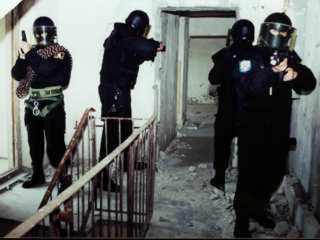 |
Back to Menu
|
Weapons
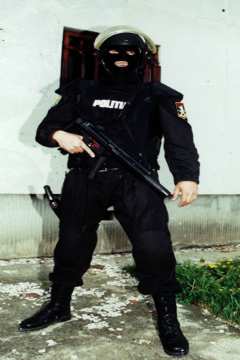 |
In its early days, DIAS members had to use whatever weapons were available. They started with Romanian-made Carpati pistols. Top of the line in their hay-days, the Carpati 7.62mm pistols were totally outdated in the modern combat environment. As "the bad guys" started to use more and more powerful weapons, it was clear that DIAS fighters need to pack a more powerful punch.
As the purchase of new weapons was not feasable at the time, DIAS members got to use Romanian-made excellent AKM machineguns. Made in various models and calibres, the 5.45 mm AKM fires 32 rounds of armour-piercing shells and has a deadly effect up to 3 km. |
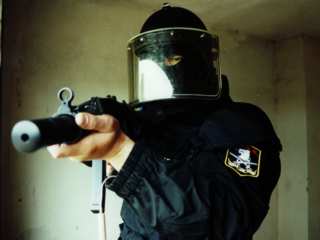 |
Most of the criminals lost their appetite for attacking the fighters at the sight of the AKM, also called "BB" by the Jandarms.
As the 90's came to an end, so did the era of lackings for the DIAS. Nowadays the DIAS fighters have clothing made of kevlar, tuaron and nomex, and are receiving goretex boots from the Police. This is a stark contrast to the past, when the fighters were purchasing their own boots and clothing.
These days DIAS members widely employ the Glock 9mm automatic pistol, which fires 18+1 armour piercing rounds. Besides the Glock, the AKM and various Western-made shotguns are also employed. Steyrhaus, Hochler&Koch and the Cugir factory are reggular weapons provider for DIAS. The usage of MP5A3 is also common. |
Back to Menu
|
Order of Battle
This is the complicated part. I have no idea how am I going to make this look simple, therefore I have decided to both explain it in words, as well as try to draw-up a scheme.
| Municipal Police |
DGPMB
(Bucharest Police) |
| DPIR |
SPIR |
| DIAS |
DIR |
DIAS |
other |
As you see in the scheme, there is a DIAS detachment in every local police command, including Bucharest. In the 40 municipalities, there is a rapid deployment structure called DPIR, or Detasamentul Politiei pentru Interventie Rapida. In Bucharest, that detachment has been expanded into an entire service, called SPIR, or Serviciul Special al Politiei pentru Interventie Rapida.
Both DPIR/SPIR structures incorporate a DIAS detachment, for special activities, as well as a bomb squad, which in some municipalities is known as DIR. Bucharest's SPIR also incorporates two more detachments, one for public order and the other for crime prevention.
|
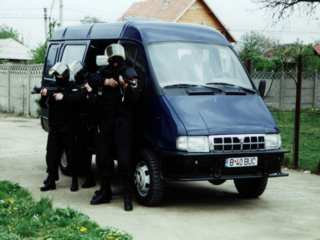 |
|
DPIR is also divided into two main subdivisions: DIAS, which is composed of the fighters, and DIR, which is the Police Bomb Squad. One has to remember that SRI also has a bomb squad section in its Anti-Terrorism Brigade, and so does the Civil Defense unit. Sometimes during bomb threats, they act together. Usually bomb threats in Romania happen very seldom and are almost always done by high school teenagers who want to skip classes. New laws have been passed in 2004 which specifically state that bomb threats represent a terrorist activity, and since then, very few such events have taken place.
|
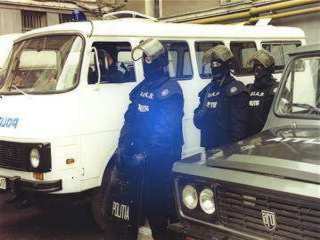 |
In the 2000s however, certain municipalities have decided to personalize the name of their DPIR's, at least one of them has also expanded it into an entire service, same as Bucharest did. We are talking about Piatra Neamt, capital of the Neamt (NT) county, where the local structure is called SIR. Other municipalities regularly use the DIAS name, such as Targu Mures and Bistrita, while most stick to the DPIR terminology.
However, most Police structures have named their rapid deployment detachment DPIR. So in conclusion, DIAS from Bucharest and DIAS from everywhere else are two different things, yet exactly the same.
Each city and town has its own DIAS detachment, composed from 15 combatants upwards, depending on the size of the city. Very good DIAS formations can be found, besides Bucharest, in cities like Timisoara, Brasov, Constanta or Galati, which are also cities with a higher crime rate. |
Back to Menu
|
Exercises
DIAS often arrange public displays and demonstrations. During the national day (december 1st), during special celebrations and sometimes even at an action movie premiere, DIAS or DPIR fighters stage hostage rescuing operations or simulate combat actions.
Although their official mission description states "to be present during Police operations that have the potential of becoming dangerous" and "to protect Police officers during arrest and search operations as well as the citizens", DIAS members also train for more complex operations, such as rescuing hostages or battling with armed gunmen.
For rescuing hostages, DIAS fighters also train in CQB (Closed-Quarters Battle), as portrayed in the picture to the right of this text.
Although hostage rescuing is not the responsibility nor speciality of DIAS (SIIAS and other forces do that), the fighters need to be prepared for any situation that could face them in the streets. |
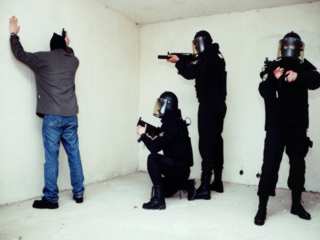 |
 In one demonstration in Galati, DIAS fighters simulated a hostage rescuing operation and a bomb squad intervention. Two persons were kidnapped in the middle of the street, right under the eyes of the policemen which were standing near by. The criminals tried to escape, but were followed by Police cars until they were surrounded. A negociation followed, among the desperate screams of the hostages and the shouting of the offenders. What followed was the quick intervention of the DIAS team. A lot of hand-to-hand combat and some shots, and the offenders have been strapped down and arrested. In one demonstration in Galati, DIAS fighters simulated a hostage rescuing operation and a bomb squad intervention. Two persons were kidnapped in the middle of the street, right under the eyes of the policemen which were standing near by. The criminals tried to escape, but were followed by Police cars until they were surrounded. A negociation followed, among the desperate screams of the hostages and the shouting of the offenders. What followed was the quick intervention of the DIAS team. A lot of hand-to-hand combat and some shots, and the offenders have been strapped down and arrested.
In another scenario, a foreign object is found by a car owner, underneath his vehicle. Zin, the sniffing dog from DIAS, is called upon and finds the bomb, which is later destroyed.
Back to Menu
|
Operations
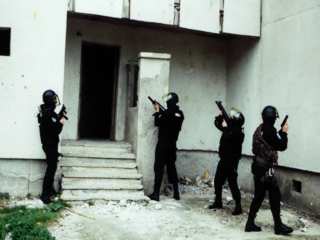 |
Also, certain criminal elements have the bad habbit of building massive personal pallaces, some of them larger than an apartment block. Curiously enough, neither the European Union nor the minority defense organizations have anything to say about those people who are 50 years old but have never worked (their job record is zero), but whom build themselves 5 million $ worth of castles. Furthermore, they never have any authorizations, nor are they willing to ask or pay for such papers. When policemen arrive to question the owners, they are usually severely beaten, and sometimes even killed. In such situations, DIAS fighters are called upon to evict the owners and take them into arrest.
Each large city in Romania is surrounded by entire villages which are composed of multi-million dollars palaces, built ilegally by people that never had a job. When they are called upon to pay their taxes, the scandal they make is utterly disgusting, ranging from pretending to kill themselves to tearing off their clothes and inflicting personal injuries, for which they later sue the policemen.
|
Such unimaginable acts are being "performed" by a certain group which has often been described by foreign media as being "discriminated".
As officers always get killed when entering those areas by themselves, entire DIAS formations need to be called for their protection, as hundreds of armed "discriminated" locals attack them with knives, swords, pick-axes and shovels, same as in the middle ages.
At one time, near the city of Timisoara, DIAS fighters were called upon to arrest a family of 15 members, which barricaded itself in the attic of a huge 4-story palace. As the ethnical and "discriminated" people use white weapons or fire arms, the fighters proceeded with great care and in the end managed to bring all of them downstairs and into the Police car. One time in the city of Constanta, a group of criminals poured acid on the DIAS fighters that were climbing the stairs of a building. Thinking at the time that it is only hot water, the chief of the formation discovered after the mission was over that the kevlar clothes have melted, thus protecting his own life from the distructive power of the acid. |
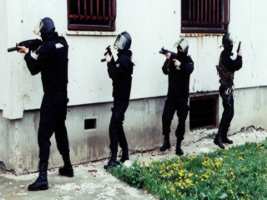 |
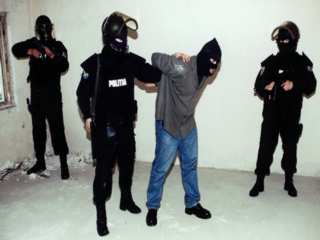 |
At the same time, IGP also had to have a special forces group for all the other cities and towns in Romania. The names changed during the 1990's and early 2000's between DIAS, DPIR, DIR and FIR. All this confusion of names adds to the blury image of these formations.
In reality, the Police special forces from the cities and towns in Romania, except Bucharest, are called DPIR. DPIR is also divided into two main subdivisions: DIAS, which is composed of the fighters, and DPIR, which is the Police Bomb Squad. One has to remember that SRI also has a bomb squad section in its Anti-Terrorism Brigade, and so does the Civil Defense unit.
So in conclusion, DIAS from Bucharest and DIAS from everywhere else are two different things, yet exactly the same. Also, DIAS and SPIR have overlapping responsibilities, as do most of Romania's Interior organizations.
Each city and town has its own DIAS detachment, composed tom 15 combatants upwards, depending on the size of the city. Very good DIAS formations can be found, besides Bucharest, in cities like Timisoara, Brasov, Constanta or Galati, which are also cities with a higher crime rate. |
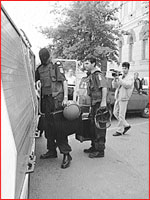 |
Up to 22 DIAS members participate in a bomb threat intervention. Seven of them are Bomb Squad specialists, and the other 15 are DIAS fighters.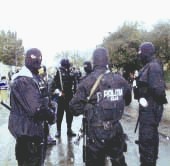 Four terrain vehicles are employed during the operation. The cost of such an intervention is above 50 $, while the fine for a fake threat call is only between 3 and 12 $. Four terrain vehicles are employed during the operation. The cost of such an intervention is above 50 $, while the fine for a fake threat call is only between 3 and 12 $.
As all of the bomb threats in 2003 have been fake, one can calculate how much money the Police and the other services have lost in operations, searching for bombs that didn't exist. As more and more fake threats are being made, higher fines seem to be the only solution to stop teenagers in search of cheap thrills.
Photo: DPIR members at an intervention. The call proved to be a fake threat.
Photo by Sorin Pana, Galati. |
Back to Menu
|
Photos
Back to Menu
|
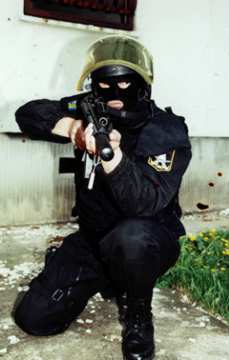






 In one demonstration in Galati, DIAS fighters simulated a hostage rescuing operation and a bomb squad intervention. Two persons were kidnapped in the middle of the street, right under the eyes of the policemen which were standing near by. The criminals tried to escape, but were followed by Police cars until they were surrounded. A negociation followed, among the desperate screams of the hostages and the shouting of the offenders. What followed was the quick intervention of the DIAS team. A lot of hand-to-hand combat and some shots, and the offenders have been strapped down and arrested.
In one demonstration in Galati, DIAS fighters simulated a hostage rescuing operation and a bomb squad intervention. Two persons were kidnapped in the middle of the street, right under the eyes of the policemen which were standing near by. The criminals tried to escape, but were followed by Police cars until they were surrounded. A negociation followed, among the desperate screams of the hostages and the shouting of the offenders. What followed was the quick intervention of the DIAS team. A lot of hand-to-hand combat and some shots, and the offenders have been strapped down and arrested.



 Four terrain vehicles are employed during the operation. The cost of such an intervention is above 50 $, while the fine for a fake threat call is only between 3 and 12 $.
Four terrain vehicles are employed during the operation. The cost of such an intervention is above 50 $, while the fine for a fake threat call is only between 3 and 12 $.